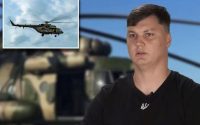‘Miracle on the Hudson’ crew, passengers relive nail-biting details of water rescue on 15th anniversary of splash into river
Some of the crew and passengers in the “Miracle on the Hudson” reunited Monday to mark the 15th anniversay of “the most successful marine rescue in aviation history.”
About 50 passengers, ferry boat operators and hospital staffers gathered at Pier 79 to honor the first responders who had jumped into action when US Airways Flight 1549 splashed down in the Hudson River on Jan. 15, 2009.
All of the passengers and crew onboard survived after a water rescue.
“It’s amazing how people come together even when they don’t know each other,” said event organizer Dave Sanderson, a passenger on the flight who has since become a motivational speaker and author.
Sanderson recalled hearing an explosion and looking out a window to see fire shooting out from under the plane. A terrifying ordeal had begun for him and the other 154 passengers and crew.
When pilot Chesley “Sully” Sullenberger announced over the plane’s public address system that the flight was going in for an emergency landing, Sanderson assumed he meant at an airport.
“It wasn’t until we crossed the George Washington Bridge that I knew this was a serious situation,” Sanderson said of the moment the flight flew just 900 feet above the crossing.
“All I could see was water,” Sanderson said at the event, near to where the plane made a water landing.
Sanderson said he remembers climbing over seats to help his fellow passengers, and was the last passenger off the plane.
“There was no room on the wing or the boat for me,” he said.
Upon hearing the now-submerged aircraft start to “groan,” Sanderson was worried it would sink. Faced with little choice, he entered the 36-degree water, unsure if he would be rescued in time, until he saw a New York Waterway ferry headed his way and decided to swim for it.
“It was the longest 15-yard swim of my life.”
Giovanni Ahmad, township manager for Weehawken, New Jersey, was an EMT back in 2009, charged with coordinating transport and resources for EMS and hospitals on the Garden State side of the Hudson.
He credited the New Jersey Port Security Initiative, a plan devised post-9/11 to strategize and coordinate emergency responses for disasters between New York and New Jersey, for the “victorious” rescue operation.
Although the plan, which was finalized just four weeks before the crash, mostly covered incidents like capsized boats or sinking ferries, its lessons were nothing short of a godsend on the day of the Miracle on the Hudson.
“We literally took that plan and said ‘there’s no difference.’ It wasn’t planned for an airplane but you treat it the same way. All the things that were set in motion for that plan were in place. We were able to act and execute 98% of it,” he said.
Also assisting in the emergency effort from the Jersey side was Dr. Hilda Roque, an internist and retired army captain, who said she was “expecting the worst” when she arrived at the scene and was relieved all of the passengers were still alive.
“They were quiet, they were following instructions,” she said of the soaking wet passengers.
“I was able to take their shoes off and incubate their feet with bags,” she recalled.
New York Waterways Capt. Vincent Lombardi, who lent a hand with the unprecedented rescue effort, is more familiar with saving sinking boats than sinking planes, he told reporters after the press conference.
“‘Plane’ isn’t written in the literature. It’s usually written ‘sinking vessel,’ but we applied what we know to that and it was successful,” he said.
“What I did first was approach the wing because they were submerged. So I figured they needed help right away. They were wet. It was cold out. There was ice in the water coming down from the bridge,” Lombardi said.
“I positioned my boat just over the top of the wing and I was using my engines to keep me level so the plane didn’t drift into me and I didn’t turn and sidle into the plane. It was very tedious,” he continued.
“I’m just thankful we were there to help. I’m thankful our training prevailed.”
Another passenger in attendance was Denise Lockie, who acts as a sort of informal social director for the 155 passengers and crew, helping them keep in touch. She wears a silver necklace of antique airplane charms she started collecting after the crash.
“I can only say that the past 15 years that’s one heavy of a day to remember: the bravery, the dignity, the respect that was shown.”
She admitted to having “blank memories” of her ordeal that day, not remembering how she got out of the plane, or onto a rescue boat, but she did remember she was on the same ferry as Captain Sully.
“I’m not 100% sure what happened, but I’m grateful,” she said.
She enthusiastically thanked first responders for their life-saving efforts.
“Without you, this could have been a tragic event and it wasn’t. So thank you from the bottom of my heart.”
As for her fellow passengers, she said, “We’re all one family. There’s nothing I can’t say about how grateful I am that I was able to go home and be with my family,” she said.
On that fateful afternoon in 2009, US Airways Flight 1549 made a perilous emergency landing in the Hudson River, just five minutes after departing LaGuardia Airport in New York City.
Soon after takeoff, as the Airbus A320 reached a height of 3,000 feet, the aircraft encountered a large flock of Canadian geese, obstructing the pilots’ field of vision. Some of the birds were sucked into the plane’s engines, both of which were immediately compromised.
Sullenberger and first officer Jeffrey Skiles, both experienced pilots, remained calm as they attempted to maneuver the imperiled aircraft back to LaGuardia. However, they soon realized their options were limited.
“We’re going to be in the Hudson,” Sullenberger famously radioed to Air Traffic Control before ditching into the river at 3:31 p.m.
All of Flight 1549’s 155 passengers and crew survived, and were pulled from the near-freezing waters within 24 minutes of the crash landing by boats large and small that flocked to the crash site to render assistance.
Sullenberger became a household name after the miraculous near-disaster, that year being ranked second in Time magazine’s “Top 100 Most Influential Heroes and Icons of 2009,” bested only by Michelle Obama.
In 2016, the incident was enshrined in celluloid with the film “Sully” starring Tom Hanks as the titular hero.


